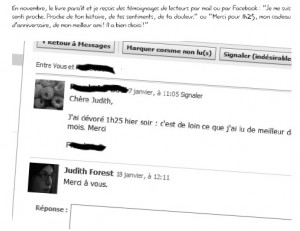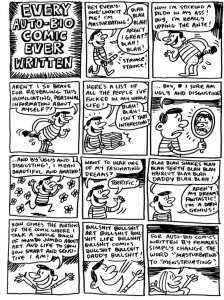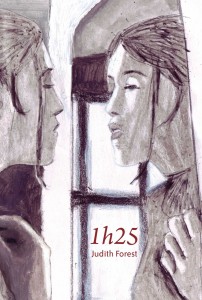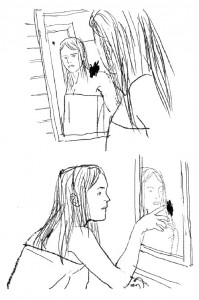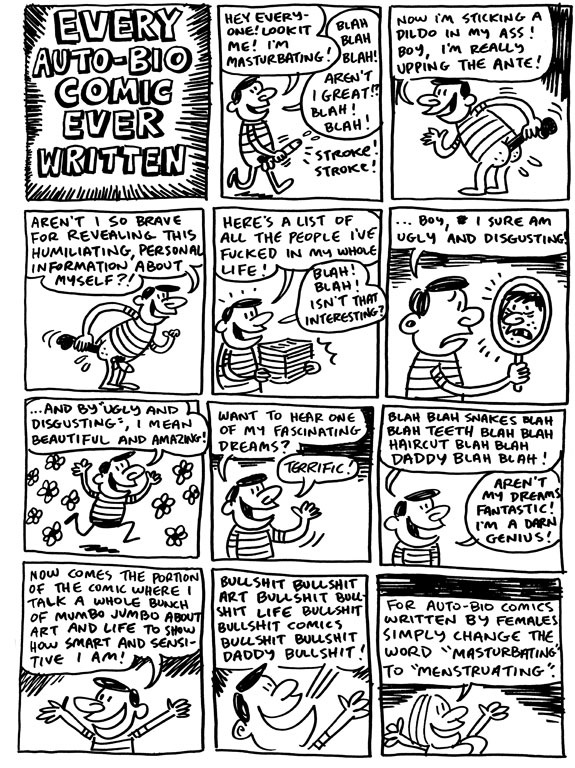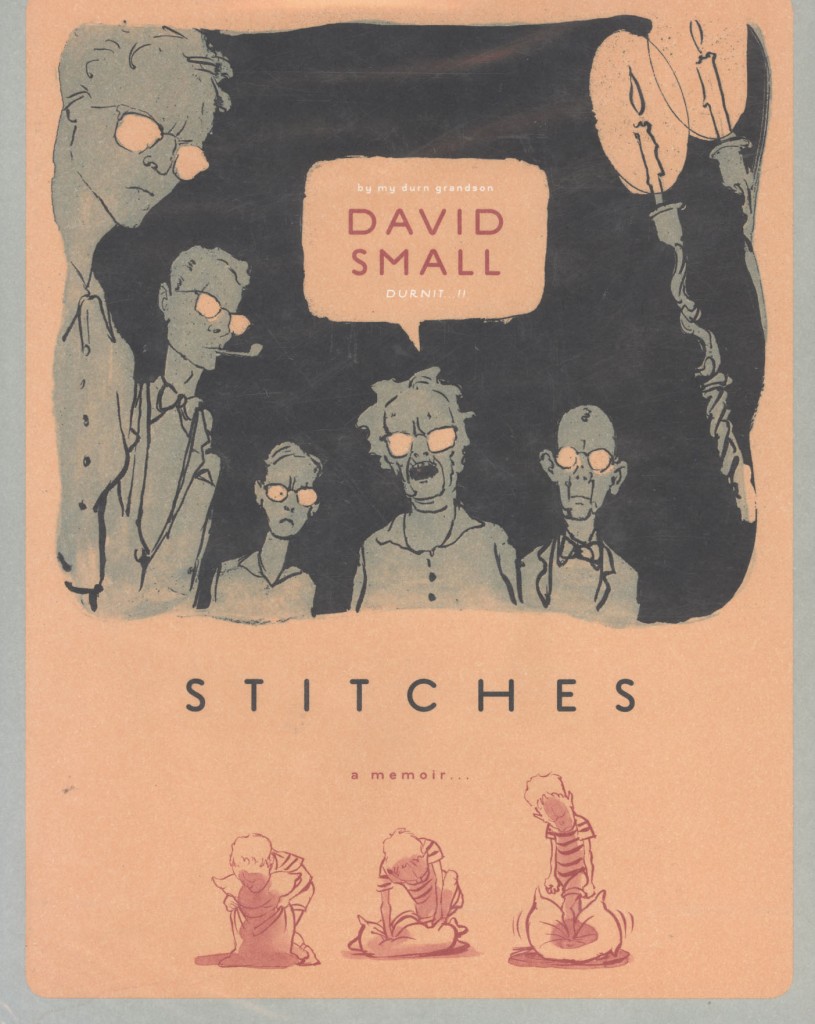
While I’m happy to participate in HU’s fifth anniversary celebration, I should make it clear that I’m a poor hater. I’ve read many comics that I dislike because I found them stupid or offensive, but rarely do my feelings escalate to the point of active hatred. By confirming my speculations about the decline of the medium, bad comics put me into a sullen funk instead of a rage. I brood better than I hate. If the following essay seems low on anger, chalk it up to my beta-male, passive-aggressive personality.
I’ll further deviate from my HU Hate-Fest Assignment by talking about a comic that on an aesthetic level is actually quite accomplished, David Small’s Stitches (2009). I came to Stitches familiar with Small’s art from a handful of terrific children’s books, including The Gardener (1997, written by Sarah Stewart, Small’s wife), a Depression-era tale of a farm girl who brings a rooftop garden and joy into the lives of her urban relatives, and So You Want to Be President (2000, authored by Judith St. George), a charming collection of stories about POTUSes past and present. Small can draw, as any sample of the Presidential caricatures in So You Want makes clear.
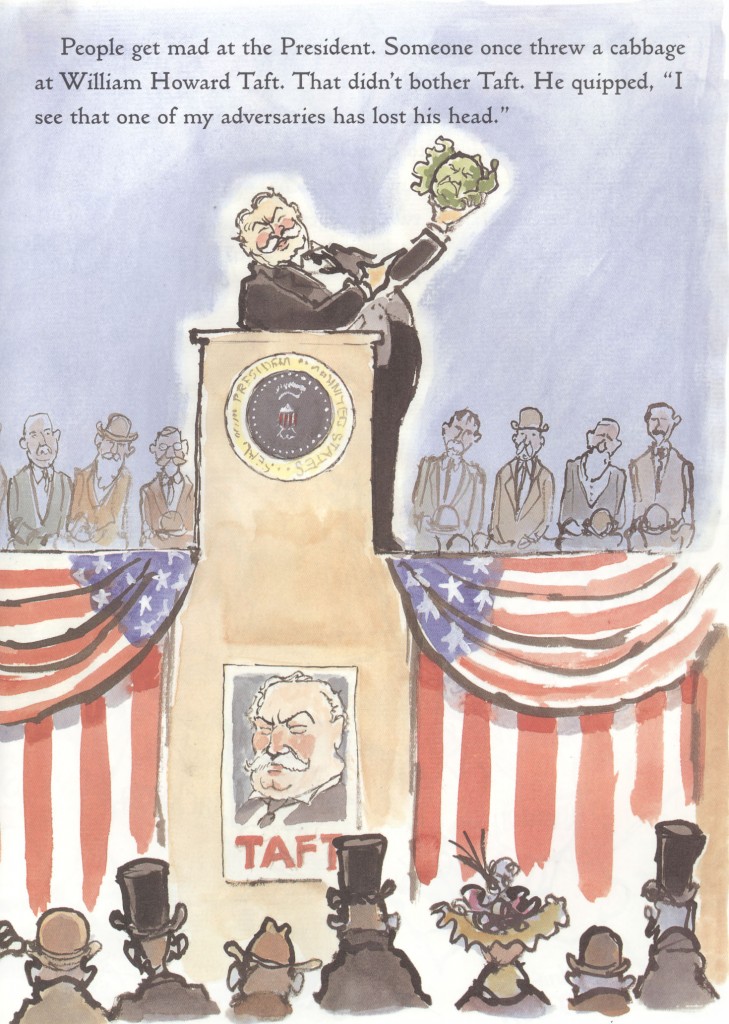
Small brings this same high level of craft to the pictures in Stitches, though I wish that publisher W.W. Norton had published the book in color. Small’s black-and-white ink washes are fluid and atmospheric, but I prefer his vibrant color work a bit more.
If I have nothing but compliments for the art in Stitches, then what’s my objection to the book? Stitches is a brutal memoir about Small’s childhood in an abusive family, whose members included his father, an emotionally distant doctor who treated David’s sinus troubles with carcinogenic X-rays; his brother, a bully who forced sensitive David to look at their father’s X-rated medical books; and his mother, a brittle, closeted lesbian prone to silent rages and devoid of any love for her sons. This is the stuff of both drama and prolonged introspection, but Small refuses to engage thoughtfully with his troubled past. His characterizations never move beyond one-dimensionality (Dad and Brother are bad, Mom the absolute nadir), and the book reads like a futile attempt to get back at those adults who damaged him as a child. Motivated by revenge, Small sacrifices one of the central ethical responsibilities of the autobiographer: to try to understand why the people in his/her life behave as they do.
I’m no scholar of autobiography, so let me consult people who are. In the excellent collection The Ethics of Life Writing (Cornell University Press, 2004), edited by Paul John Eakin, several essayists directly address the thorny dangers of writing about one’s parents and childhood. Near the beginning of his essay “Judging and Not Judging Parents,” for instance, John D. Barbour writes the following:
To the degree that a writer focuses on her relationship to a parent, she must explore the parent’s life, explaining how the parent came to have specific values and a certain moral character. It becomes harder to judge when one realizes how various influences shaped a parent’s life—including the fact that the parent, too, was once a child reacting to family pressures. If “tout comprendre, c’est tout pardoner” (to fully understand another person is to forgive), the autobiographer may find that the project of life writing makes it difficult to judge. He may recognize that a parent’s character was formed by causal influences beyond his control, for instance, during childhood or times of great duress. A writer may recognize the limits of moral judgment for other reasons as well, including a desire to forgive and awareness of the danger of judgmentalism. Intergenerational autobiography is a matter of both judging and “not-judging.” Moral judgment is not negated but made more complex by causal interpretations of behavior, by forgiveness, and by scruples about the appearance or reality of self-righteousness. (73-74)
Barbour makes other points to reinforce his claim that a memoirist’s evaluation of his/her parents is a minefield of complications. Most telling, perhaps, is his argument that “the experience of having children of one’s own” (74) can make an autobiographer realize how hard it is to be a mom or dad, and consequently be more sympathetic to one’s own parents.
Barbour’s observations are personalized by Richard Freadman’s essay “Decent and Indecent: Writing My Father’s Life,” where Freadman describes the process of researching and writing a biography of his father Paul, an Australian Jew who had, in son Richard’s words, “quite a successful career as a teacher of political science at a business school, a political commentator, and an exemplary citizen” (122). Richard Freadman further describes his father as a Decent man—a capitalized “Decent” to reflect the ubiquity of the moral norm of Decency in mid-20th century Australian culture—and as a man whose potential was limited by “dangerously low self-esteem and treacherous self-doubt” (123). Richard Freadman’s first quandary: if his father’s idea of Decency and propriety would prevent him from revealing secrets about himself and others, does the son have the right to talk about his father’s self-doubt? Does Richard Freadman have the right to write his father’s biography at all?
Throughout most of his essay, Freadman analyzes multiple definitions for the terms “trust” and “loyalty,” straining to figure out how he can be frank about his father while still remaining loyal to him. Freadman even stages imaginary dialogues with his dad, who died ten years before Freadman began the biography, and reaches a tentative peace with his father’s hypothetical disapproval:
I’d like to think that in putting many facets of my father on record, as I have done here, I have brought a fine man back to life for the contemplation of others. In the end, I have to leave it to the reader of the book to decide where, if anywhere, the essential Paul Freadman resides, and what he would have felt about this book. I hope I haven’t subjected a profoundly decent man to unreasonable narrative indecency. I hope I have done the right thing in publishing this auto/biography. I think I probably have. (145)
These essays by Barbour and Freadman, and most of the other pieces in The Ethics of Life Writing, posit that autobiography is a tricky genre that requires, at the very least, authors who recognize and contemplate the dilemmas implicit in writing about the family that shaped their earliest years. Can we ever be objective about our parents? Should we even bother to chase some ephemeral notion of “objectivity” in our memoirs? “They fuck you up / Your mum and dad” and can we forgive them enough to represent them somewhat fairly and three-dimensionally in our memories and books?
When I read Stitches, I see no forgiveness, and few attempts by Small to understand his Mom and Dad outside their rotten parenting. Dad comes off a bit better than Mom, if only because Small defines him as the typical post-war absent patriarch. He’s present at the family’s dirge-like suppers, but escapes soon afterwards, either to his punching bag in the basement or to some undisclosed destination in his car. Perhaps the most harrowing passages in Stitches have to do with David’s illness—his two operations, his first sight of his neck scar (“My smooth young throat slashed and laced back up like a bloody boot”) and, most wrenchingly, his discovery that his parents hid a cancer diagnosis from him—and Dad is a full co-conspirator with Mom in all these lies and injustices. Dad is redeemed somewhat, however, at the end of Stitches, in a key moment (its importance underlined by a full-page splash) where he assumes his responsibility for the overdose of X-rays that he gave his own child.
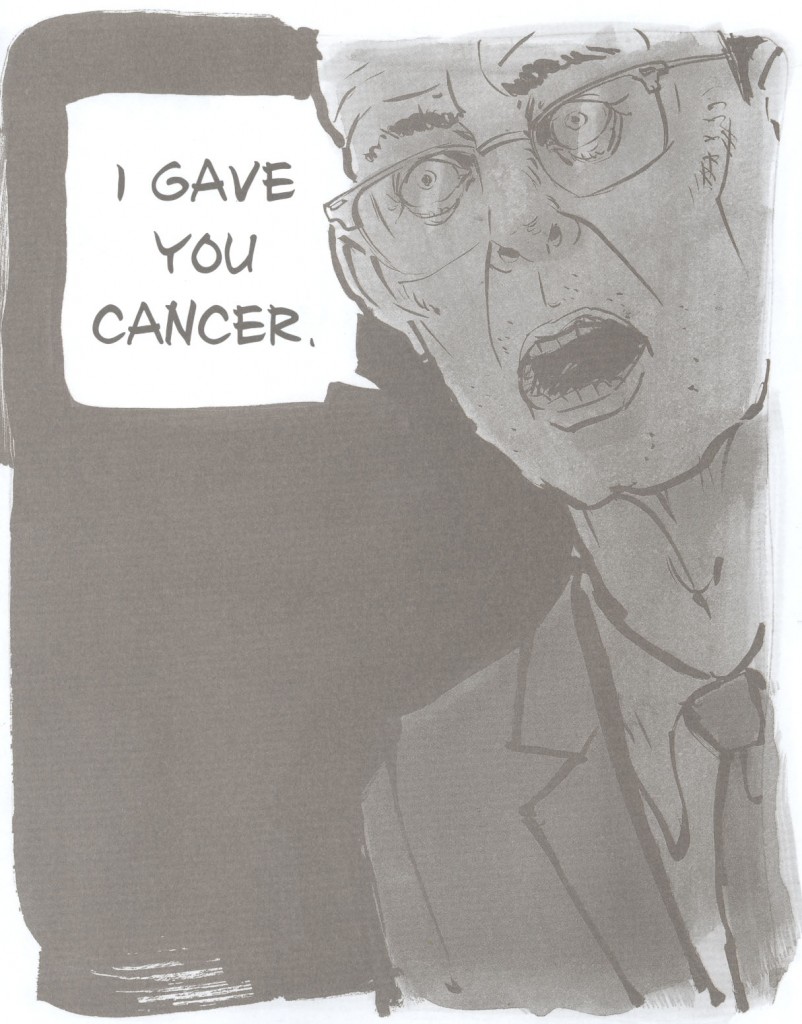
After this moment of truth, Dad drops out of the book, only to reappear briefly in an appendix that includes a photograph of Small’s Dad, and a note indicating that after Mom’s death, father “remarried—happily this time—and lived to the ripe old age of 84” (328). Dad gets a happy ending and relatively benign treatment from his son, although he never emerges as a fully fleshed-out character, partially because certain questions about him remain unanswered. Where did he go at night when he went out driving? What motivates him to confess to David about the cancer? For me, the biggest problem is that Small gives us no information about how two such spectacularly incompatible people managed to marry and have children. The family dysfunction is presented as a fait accompli; Small never analyzes his father’s past, never tries to explain how his father’s character was shaped by moral lapses, poor choices (particularly in a wife) or (in Barbour’s words) “causal influences beyond his control.” As a result, father Small remains a cypher.
Small’s mother was a terrible person, and Stitches is a catalog of the ways she abused her children. She keeps the domestic situation tense by slamming cupboards and refusing to speak; she slaps David when he loses his shoes; she goes on a shopping spree instead of using the money to pay for David’s doctors; she burns David’s library of paperback books because he was reading “smut” like Nabokov’s Lolita (1955); she sends David away to boarding school, and rages when the school administrators send him back home; and she hardens even more towards David when he accidently catches her in a tryst with another woman.
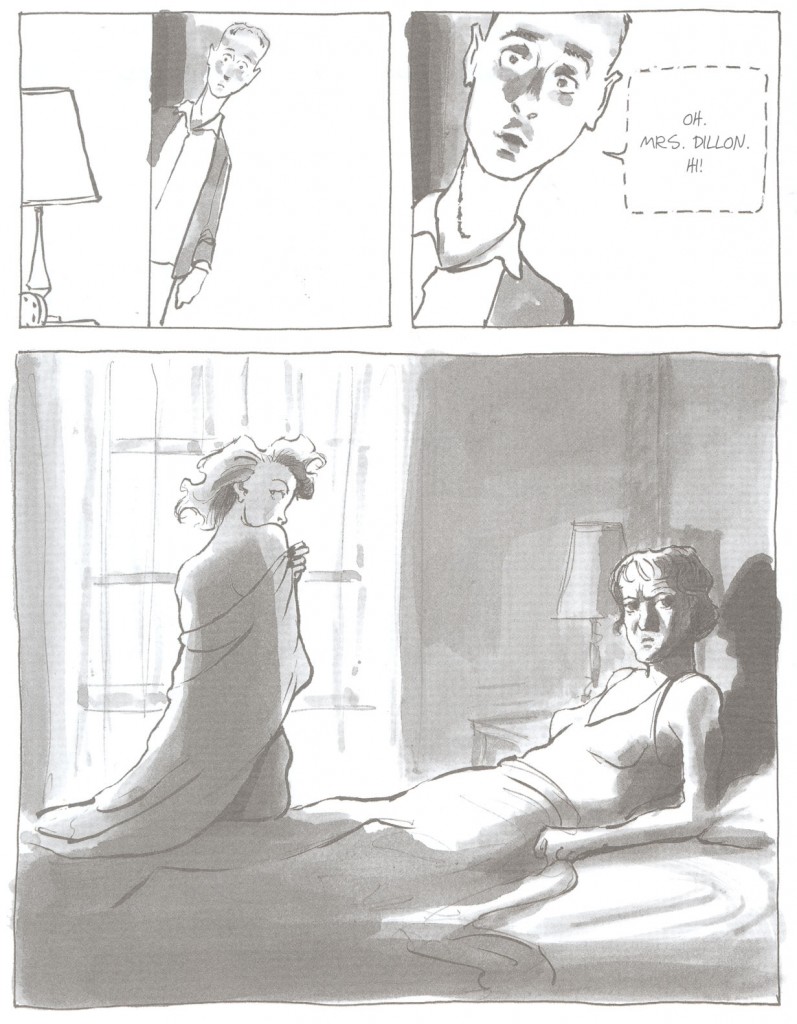
Small’s messed-up relationship with his mother is the fuel for two of Stitches’ epiphanies. The book’s acknowledgements include a special thank you “to Dr. Harold Davidson, for pulling me to my feet and placing me on the road to the examined life” (331), and though he’s never identified by name in the story, Dr. Davidson is clearly the psychotherapist that facilitates the healing of fifteen-year-old David about three-fourth of the way into Stitches. Davidson is drawn as the White Rabbit in Alice in Wonderland (1865)—one of a cluster of motifs that show how Alice’s playful escapism was a lifesaver for David—and in their first session tells David the blunt truth: “Your mother doesn’t love you” (255). The next several pages show David’s tears expanding to drench all the objects and locales in his barren suburban world.
Another of David’s key insights comes as a dream at the conclusion of Stitches. He’s a child again, looking out the window of a large house; he sees his mother sweeping a path to an insane asylum, “the one where Grandma had been locked away” (324). Mental illness ran in Small’s maternal family—his great-grandmother was a kleptomaniac, his grandmother a would-be homicidal arsonist—and he interprets this dream as an invitation to succumb to his own demons, to follow his grandmother and mother into insanity. His response is two words on an otherwise blank page: “I didn’t” (325). Stitches is the story of how David learns to live without mother love, and without going mad.
Small’s decision to focus almost exclusively on his own journey, however, prevents him from diving into the points-of-view of other characters. I don’t want to defend Small’s mother—there’s no excuse for how she mistreated her two sons—but David isn’t interested in finding any explanations for her behavior. Throughout most of Stitches, Mom is shown to be unworthy of our empathy or understanding, a cross-eyed ogre that David must transcend to become a well-adjusted, psychically healthy person.
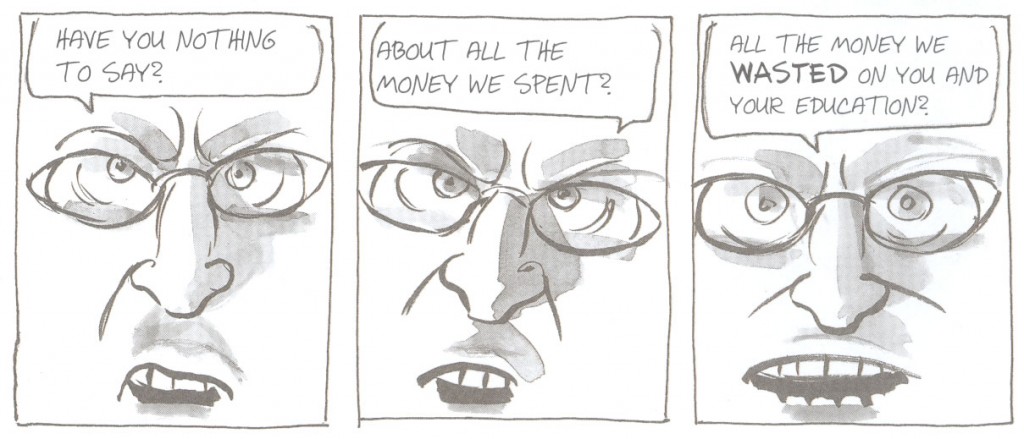
But therein lies the paradox: the more Small presents his mother as the evil villain, and himself as the heroic victim, the more we realize that he didn’t grow up to be well-adjusted, and that much of Stitches is about settling scores with a ghost rather than reaching any cathartic truce with his past. His maternal grandmother was a deeply disturbed woman, but Small doesn’t consider how this made his mother’s childhood a horror too. In Stitches’ appendix, Small describes his mother’s physical problems—“Born with her heart on the wrong side of her chest, she suffered from multiple heart attacks towards the end of her life. She also had only one functioning lung” (327)—but gives no attention to how these infirmities might have twisted her personality. And Mom’s lesbian desires are played mostly for laughs, especially in a party scene where she shamelessly flirts with a glamorous family friend, but I can only imagine what a grind it must’ve been to be gay or otherwise sexually non-normative in the Mad Men era. (In Dress Codes: Of Three Girlhoods—My Mother’s, My Father’s and Mine [2002], Noelle Howey writes that the incompatibility between her father’s biology and his gender identity was so agonizing for him that he had to change his sex to become a nice person.) While reading Stitches, I kept hoping for some consideration of his mother’s difficulties, for some of Barbour’s “judging and non-judging” and Freadman’s thoughtful ambivalence. No luck. Thirty-four years after his mother’s death, Small is still pissed, still too close to his subject, and his continuing hatred for his mother flattens her into a one-dimensional monster.
There’s only one moment in Stitches where Small hints at any empathy for his Mom. About a third into the book, after Grandmother scalds David’s hands with hot tap water and sends him to bed early, Mom returns to Grandma’s house. David explains to Mom how he’s been mistreated, and he’s about to say that his Grandmother is insane when his mother silences him:
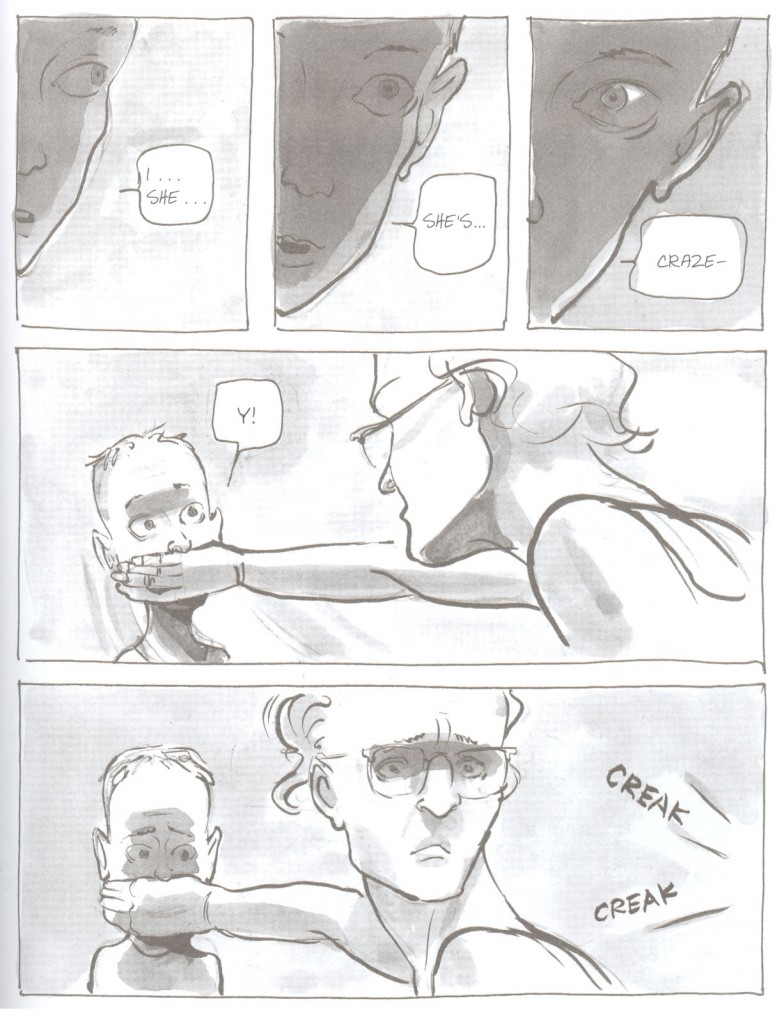
That look on Mom’s face in the last panel is one of the few times in Stitches she’s drawn expressing an emotion other than hatred or contempt. Even as an adult, she’s afraid of her mentally ill mother, and we understand that she’s been irrevocably scarred by forces beyond her control. Retroactively, Small also feels for his Mom—little David can’t see her face as she turns away, but the adult artist intuitively knows that she’s become an animal in a trap. This moment of insight and empathy passes quickly, however, and Small’s mother snaps into her role as Sauron for the rest of the book.
The moment I find most depressing in Stitches comes in the appendix, where Small writes the following about his mother: “If this had been her story, not mine, her secret life as a lesbian would certainly have been examined more closely” (327). The essays in The Ethics of Life Writing define memoir as a genre that obligates its practitioners to trace connections and influences among individuals, family members, social forces, ideological beliefs; Small instead builds false walls between himself and his mother, pretending that her “secret life as a lesbian” didn’t affect her character and, by extension, himself. The best memoirs remind us that we are part of each other, but in Stitches Small stands apart, refusing to extend empathy or forgiveness. The result is an autobiography that feels, well, small.
Click here for the Anniversary Index of Hate.
